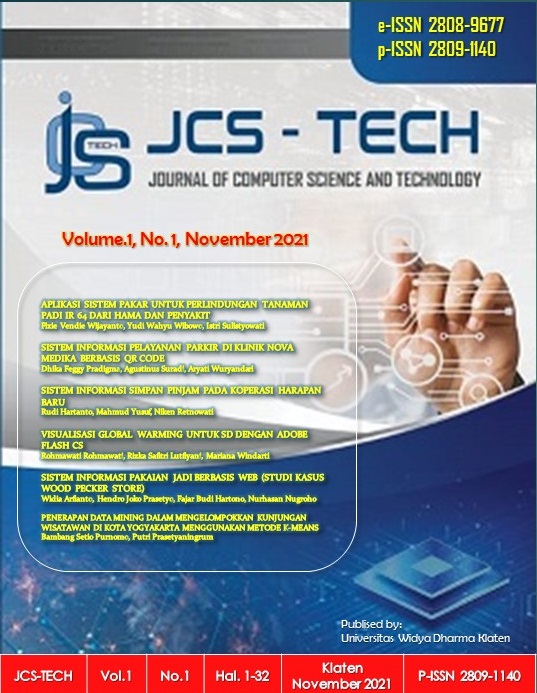PENERAPAN DATA MINING DALAM MENGELOMPOKKAN KUNJUNGAN WISATAWAN DI KOTA YOGYAKARTA MENGGUNAKAN METODE K-MEANS
DOI:
https://doi.org/10.54840/jcstech.v1i1.38Abstract
Yogyakarta is one of the cities in Indonesia that has a tourist attraction and is a tourist destination that is most in demand by tourists, seen from the number of tourist visits that are increasing from year to year. Apart from being a tourist city, Yogyakarta is a city of students, a city of culture and a city of struggle. Because Yogyakarta is called a tourist city, there are many kinds of tourist objects offered by the City of Yogyakarta. In this case, the application of data mining can be a solution in analyzing data. Clustering is included in descriptive methods, and also includes unsupervised learning where there is no previous object class definition. So that clustering can be used to determine class labels for data whose class is not known. The K-Means method is included in partitioning clustering which separates data into separate parts. The K-Means method is well known for its ease and ability to group large data and outliers very quickly. from the data entered and has been processed through the K-Means algorithm method that has performed iterations 5 times by choosing cluster 1, cluster 2, cluster 3 randomly (random) with cluster 1 having 24 data with a percentage of (50%), cluster 2 has 11 data with a percentage of (23%), and cluster 3 has 13 data with a percentage of (27%).
References
. Dinas Kebudayaan Kota Yogyakarta (2018) Data Kunjungan Wisatawan Ke Objek Wisata Dari Pengelola Objek Wisata Dan. Yogyakarta.
. Gustientiedina, G., Adiya, M. H. and Desnelita, Y. (2019) ‘Penerapan Algoritma K-Means Untuk Clustering Data Obat-Obatan’, Jurnal Nasional Teknologi dan Sistem Informasi, 5(1), pp. 17–24. doi: 10.25077/teknosi.v5i1.2019.17-24.
. Irfiani, E. and Indriyani, F. (2020) ‘Algoritma K-Means Untuk Clustering Rute Perjalanan Wisata Pada Agen Tour & Travel’, Indonesian Journal of Computer Science, 9(1), pp. 44–52. doi: 10.33022/ijcs.v9i1.244.
. Mardalius, M. (2018) ‘Pemanfaatan Rapid Miner Studio 8.2 Untuk Pengelompokan Data Penjualan Aksesoris Menggunakan Algoritma K-Means’, Jurteksi, 4(2), pp. 123–132. doi: 10.33330/jurteksi.v4i2.36.
. Maulida, L. (2018) ‘Penerapan Datamining Dalam Mengelompokkan Kunjungan Wisatawan Ke Objek Wisata Unggulan Di Prov. Dki Jakarta Dengan K-Means’, JISKA (Jurnal Informatika Sunan Kalijaga), 2(3), p. 167. doi: 10.14421/jiska.2018.23-06.
. Nurjanah, M. and Arifin, T. (2021) ‘Penerapan Algoritma K-Means Untuk Analisis Data Ulasan Di Situs Tripadvisor’, Jurnal Responsif : Riset Sains dan Informatika, 3(1), pp. 75–82. doi: 10.51977/jti.v3i1.395.
. Sari, R. W. and Hartama, D. (2018) ‘Data Mining : Algoritma K-Means Pada Pengelompokkan Wisata Asing ke Indonesia Menurut Provinsi’, Seminar Nasional Sains & Teknologi Informasi (SENSASI), pp. 322–326.
. Sugiono et al. (2019) ‘Pengelompokan Perilaku Mahasiswa Pada Perkuliahan E-Learning dengan K-Means Clustering’, Jurnal Kajian Ilmiah, 19(2), pp. 126–133.
. Windarti, M. and Prasetyaninrum, P. T. (2020) ‘Prediction Analysis Student Graduate Using Multilayer Perceptron’, 440(Icobl 2019), pp. 53–57. doi: 10.2991/assehr.k.200521.011.
Downloads
Published
How to Cite
Issue
Section
License
Copyright (c) 2021 Journal of Computer Science and Technology

This work is licensed under a Creative Commons Attribution-NonCommercial 4.0 International License.




